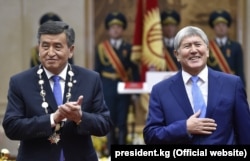
Former Kyrgyz President Almazbek Atambaev has spent months “on the ropes,” as they say in boxing.
Atambaev had supported Sooronbai Jeenbekov to become president in Kyrgyzstan’s October 2017 presidential election. He repeatedly said Jeenbekov would continue his policies, and there were suspicions that Atambaev saw himself remaining as the real power behind the scenes.
Things did not turn out that way.
Atambaev was quickly distanced from any role in government, and he started criticizing Jeenbekov’s performance and publicly expressing regret he had supported Jeenbekov.
Many officials from Atambaev’s administration have been detained and put on trial on corruption charges since he left office in November 2017. And investigations into alleged corruption by Atambaev-era officials seemed to be marching steadily toward Atambaev himself.
At the end of June, Kyrgyzstan’s parliament voted to strip Atambaev of his immunity from prosecution (as a former president), opening the way for prosecutors to investigate possible violations Atambaev may have committed as head of state.
The Interior Ministry has summoned him for questioning three times this month, and Atambaev has ignored the summonses. He had also effectively barricaded himself in his family compound outside Bishkek, brought in some of his supporters, and said there were guns on the premises and that they would be used if anyone came to detain him.
But his days looked numbered.
That changed on July 24, when Atambaev made good on suggestions that he was going to fly to Moscow. There, he met with President Vladimir Putin, and the Russian leader's thinly veiled comments indicated Moscow would be dissatisfied if legal proceedings against Atambaev continued.
And every politician in Kyrgyzstan will remember what Russia has already shown it can do to influence Kyrgyzstan’s political process.
Speaking after his meeting with Atambaev, Putin offered words of support for Jeenbekov and his government and called for the Kyrgyz to “unite around the current president and help him in developing the state.”
But Putin also said, “Kyrgyzstan has endured several serious internal political shocks...at least two.” Putin added that the “country needs political stability.”
The two "internal political shocks" that Putin was referring to are almost certainly Kyrgyzstan’s revolutions in 2005 and 2010, each of which resulted in the ousting of a president.
Russia played a role in Kyrgyzstan’s 2010 revolution.
Kyrgyzstan’s president after the 2005 revolution was Kurmanbek Bakiev, who eventually came to be seen as an untrustworthy ally by Moscow. Russia promised huge loans to Kyrgyzstan to develop its hydropower potential, which also would ease Kyrgyzstan's dependence on its Central Asian neighbors for energy supplies. The deal possibly included an understanding that Kyrgyzstan would evict U.S. forces from Bishkek’s Manas International Airport, where they had set up a small base to support operations in Afghanistan since December 2001.
Bakiev struck a new deal with the United States, and Bakiev’s son Maksim and some of Maksim’s friends were accused by Moscow of skimming money from the first Russian loan of some $450 million to invest in other ventures, seemingly hoping for a quick profit before returning the money.
Russian TV is widely available in Kyrgyzstan, and it started carrying highly critical reports about President Bakiev and his son. There were already protests in Kyrgyzstan against utility-fee hikes. Russian media added fuel to the fire with coverage of Bakiev and his family, and by April 2010, Bakiev was chased from office.
That's not the end of the story.
One of the most popular politicians to emerge from the 2010 revolution was Omurbek Tekebaev, the leader of the Ata-Meken (Fatherland) party. Ata-Meken seemed a sure bet to take the most seats in the early parliamentary elections called for October 2010, and Tekebaev himself appeared set to become Kyrgyzstan’s prime minister after those elections. Instead, Ata-Meken got the fewest votes among the five parties that won seats in the elections and Atambaev became prime minister.
Tekebaev was clearly pro-Western in his views, and Russian TV had started airing critical reports about Tekebaev several months before the elections.
The episode appeared to establish that Russia can use soft power to shape events inside Kyrgyzstan.
Now, Putin’s comments on July 24 seem to indicate the Kremlin wants the Atambaev-Jeenbekov feud to end right away. Russia has a military base at Kant in Kyrgyzstan, and the Kremlin has generally pushed back against signs of revolution in the space of the Commonwealth of Independent States (CIS) while also signaling that it does not want to see political tensions rise again in Kyrgyzstan.
And Moscow may have already flexed its muscles by enabling Atambaev to leave his barricaded compound in Kyrgyzstan to travel to Russia from Kant aboard a specially arranged private plane to Moscow.
Atambaev has vowed to return, and now there seems no reason he should not. Putin just implicitly guaranteed Atambaev’s security, although Putin’s references to stability might also send the message to Atambaev that he should cease his criticism of Jeenbekov.
Putin’s warning could quiet the situation for a while.
But such an outcome won't satisfy many people in Kyrgyzstan, and it's unlikely that anything has been forgiven or forgotten in Bishkek.









